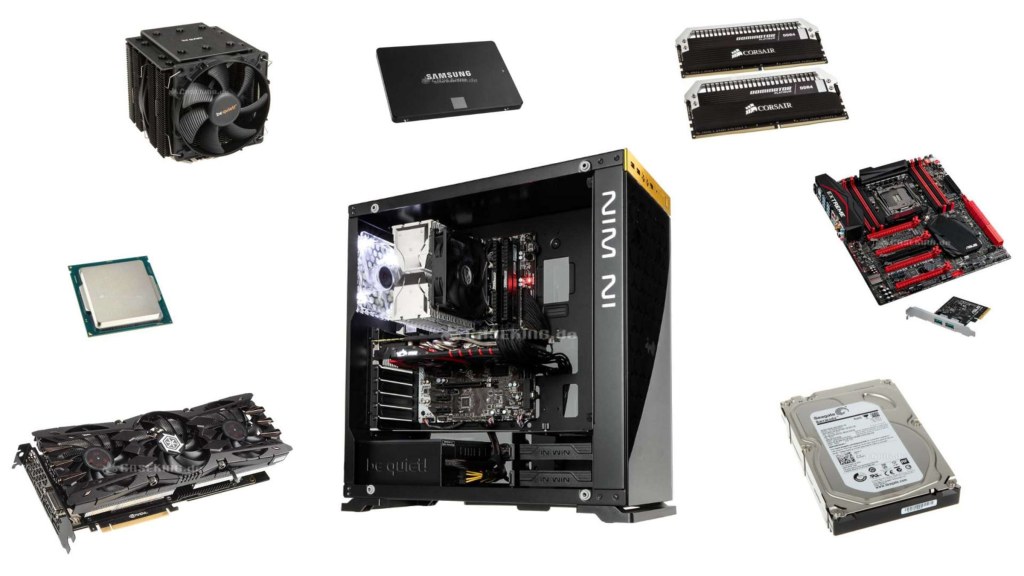Create Your Ultimate Computer: Master The Art Of Zusammenstellen Hardware!
Computer Zusammenstellen Hardware: A Guide to Choosing the Right Components
Introduction
Dear Readers,
1 Picture Gallery: Create Your Ultimate Computer: Master The Art Of Zusammenstellen Hardware!

Welcome to our guide on computer zusammenstellen hardware! In this article, we will explore the various components that make up a computer and provide you with valuable insights on how to choose the right hardware. Building your own computer allows you to customize it to your specific needs, ensuring optimal performance and reliability. Whether you’re a gaming enthusiast, a creative professional, or simply looking to upgrade your existing system, this guide will help you make informed decisions. Let’s dive in!
What is Computer Zusammenstellen Hardware?

Image Source: ingame.de
🖥️ Computer zusammenstellen hardware refers to the individual components that are used to build a custom computer system. These components include the processor, motherboard, memory, storage devices, graphics card, power supply, and peripherals such as the keyboard and mouse. Each component plays a crucial role in determining the overall performance and functionality of the computer.
Who Should Consider Building Their Own Computer?
👥 Building your own computer is a great option for tech enthusiasts, gamers, content creators, and professionals who require specific hardware configurations. By customizing your system, you can ensure that it meets your unique requirements. Additionally, building your own computer can be a rewarding and educational experience, allowing you to gain a deeper understanding of the inner workings of a computer.
When is the Right Time to Build a Custom Computer?
⌚ The decision to build a custom computer depends on various factors, including your current needs, budget, and the availability of new hardware technologies. If your existing computer is outdated or no longer meets your requirements, it might be a good time to consider building a new system. Additionally, if you need a high-performance workstation for tasks such as video editing or 3D rendering, building a custom computer can provide you with the necessary power and flexibility.
Where to Source the Components for Your Custom Computer?
🌐 When building a custom computer, it’s important to source your components from reliable and reputable vendors. You can purchase components from online retailers, local computer stores, or specialized hardware suppliers. Compare prices, read reviews, and ensure that the components are compatible with each other. It’s also advisable to check for warranty and return policies in case any issues arise.
Why Choose Custom Hardware Over Pre-Built Systems?
❓ Custom hardware offers several advantages over pre-built systems. Firstly, you have complete control over the components that go into your computer, allowing you to prioritize performance, reliability, or specific features. Additionally, custom hardware often offers better upgradeability, as you can easily replace or upgrade individual components as technology advances. Finally, building your own computer can be a cost-effective option, as you can choose components that fit your budget without paying for unnecessary features.
How to Build a Custom Computer: A Step-by-Step Guide
🔧 Building a custom computer requires careful planning and attention to detail. Here’s a general overview of the steps involved:
1. Define Your Needs:
Begin by determining your specific requirements and intended use for the computer. This will help you choose the right components and prioritize your budget accordingly.
2. Research and Choose Components:
Thoroughly research each component and select ones that offer the best performance, compatibility, and reliability within your budget. Consider factors such as processor speed, memory capacity, storage type, and graphics capabilities.
3. Assemble the Components:
Follow the manufacturer’s instructions to assemble the components into the computer case. Take care to handle the components delicately and ensure proper connections.
4. Install the Operating System:
Once the hardware is assembled, install your preferred operating system and necessary drivers. Follow the on-screen prompts and ensure that all software updates are applied.
5. Test and Optimize:
After installation, thoroughly test your computer for stability and performance. Adjust BIOS settings, install necessary software, and update drivers as needed.
6. Enjoy Your Custom PC:
Once your custom computer is up and running, enjoy the benefits of a system tailored to your needs. Regularly maintain and update your computer to ensure optimal performance and longevity.
Advantages and Disadvantages of Custom Computer Hardware
Advantages:
✅ Increased performance and reliability
✅ Customizability and flexibility
✅ Cost-effectiveness
✅ Better upgradeability
✅ Better cooling and airflow options
Disadvantages:
❌ Requires technical knowledge
❌ Time-consuming
❌ Potential compatibility issues
❌ Limited warranty coverage compared to pre-built systems
Frequently Asked Questions (FAQs)
1. Can I build a custom computer if I have no technical knowledge?
Building a custom computer does require some technical knowledge. However, there are plenty of online resources, tutorials, and communities that can guide you through the process. If you’re a beginner, consider starting with a simpler build or seek assistance from a knowledgeable friend or professional.
2. Is building a custom computer more expensive than buying a pre-built system?
The cost of building a custom computer can vary depending on the components you choose. In some cases, building your own computer can be more cost-effective, as you can avoid paying for unnecessary features. However, if you require high-end components or specialized hardware, the cost may be higher compared to pre-built systems.
3. Can I upgrade a custom-built computer in the future?
Yes, one of the advantages of building a custom computer is the ability to easily upgrade individual components. As technology advances, you can replace or upgrade your processor, memory, storage, and graphics card to keep up with the latest requirements.
4. What are the most important components to consider when building a gaming PC?
For a gaming PC, the most important components to consider are the graphics card, processor, memory, and storage. These components directly impact gaming performance and should be chosen with the specific requirements of the games you intend to play in mind.
5. Are custom-built computers more reliable than pre-built systems?
Custom-built computers can be just as reliable as pre-built systems, provided that quality components are used and proper assembly techniques are followed. However, building a computer requires attention to detail, and any mistakes during assembly or component selection can affect reliability. It is recommended to research and choose reputable brands and components to ensure reliability.
Conclusion
In conclusion, building your own computer allows you to create a system that perfectly matches your needs and preferences. From gaming to professional workstations, custom computer hardware provides the flexibility, performance, and upgradeability that many users desire. By following the steps outlined in this guide and considering the advantages and disadvantages, you can confidently embark on your journey to build a custom computer. Happy computing!
Best Regards,
The Computer Hardware Team
Final Remarks
📢 Disclaimer: The information provided in this article is for educational purposes only. We do not guarantee the accuracy, completeness, or reliability of any information presented. Building a custom computer requires technical knowledge, and it is recommended to seek assistance from professionals if you are unsure. We are not responsible for any damages or losses incurred as a result of following the advice or instructions provided in this article. Proceed at your own risk.
This post topic: Computer Hardware
